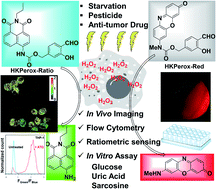Fluorescent probes for in vitro and in vivo quantification of hydrogen peroxide†
Abstract
Hydrogen peroxide (H2O2) plays essential roles in redox signaling and oxidative stress, and its dynamic concentration is critical to human health and diseases. Here we report the design, syntheses, and biological applications of HKPerox-Red and HKPerox-Ratio for quantitative measurement of H2O2. Both probes were successfully applied to detect endogenous H2O2 fluxes in living cells or zebrafish, and biological effects of multiple stress inducers including rotenone, arsenic trioxide, and starvation were investigated. As H2O2 is a common by-product for oxidase oxidation, a general assay was developed for ultrasensitive detection of various metabolites (glucose, uric acid, and sarcosine). Moreover, cellular H2O2 measurements were achieved for the first time by combining flow cytometry with live cell calibration. This study provides a pair of unique molecular tools for advanced H2O2 bio-imaging and assay development.



 Please wait while we load your content...
Please wait while we load your content...